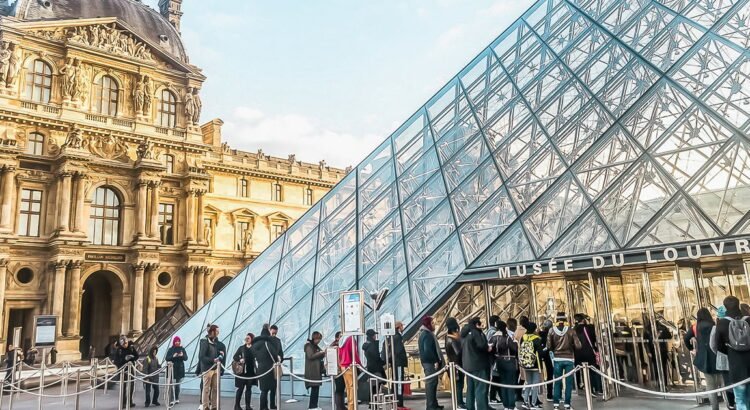
When one thinks of Paris, images of romance, elegance, and rich history immediately come to mind. Among its most celebrated icons stands the Louvre Museum—the world’s largest art museum and a cultural sanctuary that draws millions of visitors each year. From the enigmatic smile of the Mona Lisa to the grandeur of ancient sculptures, the Louvre is not just a museum—it is a journey through the evolution of human creativity, housed beneath a magnificent glass pyramid that has become a global architectural symbol.
A Monumental Beginning: From Fortress to Cultural Beacon
The history of the Louvre is as rich and layered as the masterpieces it holds. Originally built in the late 12th century as a medieval fortress by King Philippe Auguste, the structure was transformed into a royal palace during the Renaissance. By the late 18th century, amidst the Enlightenment and revolutionary fervor, the Louvre was converted into a public museum—reflecting the belief that art and knowledge should belong to all people, not just royalty.
Today, the Louvre is a monument to history itself—both in the architecture of its palatial wings and in the priceless works of art displayed within.
Architectural Marvel: The Glass Pyramid and Beyond
At the heart of the Louvre’s transformation into a modern cultural landmark stands the glass pyramid, designed by architect I. M. Pei and inaugurated in 1989. Initially controversial for its bold modernism in the classical courtyard, the pyramid has since become a beloved icon—a symbol of the museum’s fusion of past and present.
The pyramid functions as the museum’s main entrance, welcoming visitors into a vast underground concourse that connects the museum’s three major wings: Denon, Sully, and Richelieu. From the elegant corridors of the Renaissance to grand staircases and light-filled galleries, every part of the Louvre feels like stepping into a different era.
Home of the Mona Lisa
No visit to the Louvre is complete without standing before the Mona Lisa—Leonardo da Vinci’s most famous work and arguably the most recognized painting on Earth. Housed in a climate-controlled glass case within the Denon Wing, the small portrait commands massive crowds.
Her smile is subtle, her gaze captivating, and her story shrouded in mystery. Why is she smiling? Who was she? How did da Vinci capture such human depth? These questions continue to fascinate art lovers, historians, and casual visitors alike. The Mona Lisa is more than just a painting; she is a cultural phenomenon, a symbol of artistic mastery and eternal intrigue.
Vast and Diverse Collections: Art Across Civilizations
Beyond the Mona Lisa, the Louvre houses over 480,000 works, with around 35,000 on display at any given time. The museum’s vast collection is divided into eight curatorial departments, each offering a unique perspective on humanity’s creative legacy.
1. Egyptian Antiquities
Explore the grandeur of ancient Egypt with sarcophagi, statues, and hieroglyphic inscriptions. Highlights include the Seated Scribe, the Great Sphinx of Tanis, and mummies that bring 4,000-year-old stories to life.
2. Near Eastern Antiquities
Witness the birth of civilization through Mesopotamian, Sumerian, and Assyrian artifacts. Admire the Code of Hammurabi, one of the oldest written legal codes in human history.
3. Greek, Etruscan, and Roman Antiquities
Marvel at the beauty of classical art, including the Venus de Milo and the Winged Victory of Samothrace, two of the museum’s most iconic sculptures.
4. Islamic Art
This department features exquisite pieces from across the Islamic world, from calligraphy and ceramics to metalwork and textiles, spanning 1,300 years and vast geographies.
5. Sculpture
Explore masterpieces from medieval times to the 19th century, including works by Michelangelo, Canova, and Houdon.
6. Decorative Arts
Discover royal furniture, tapestries, jewelry, and artifacts that once adorned the palaces of France’s kings and queens.
7. Paintings
Beyond the Mona Lisa, this department houses works by the great masters: Delacroix’s Liberty Leading the People, Vermeer’s Lacemaker, Rembrandt’s self-portraits, and stunning Italian Renaissance canvases.
8. Prints and Drawings
A treasure trove for scholars and enthusiasts, this collection includes sketches, etchings, and studies by some of the world’s greatest artists, including da Vinci, Dürer, and Raphael.
More Than a Museum: The Louvre as Cultural Experience
The Louvre is not just about observing art—it’s about experiencing the passage of time, the evolution of expression, and the enduring human quest for beauty and meaning. Visitors can walk through 8,000 years of history, from Mesopotamian tablets to 19th-century Romanticism, all under one roof.
In addition to exhibitions, the museum offers:
- Guided tours and audio guides in multiple languages.
- Workshops and lectures for art students and families.
- Special exhibitions that bring fresh perspectives to ancient and modern themes.
- Night openings that allow guests to explore the museum under atmospheric lighting.
- Louvre Kids programs, making art accessible to younger generations.
Tips for Visiting the Louvre
To make the most of your visit:
- Buy tickets in advance to skip the long lines at the pyramid entrance.
- Arrive early or late in the day to avoid peak crowds.
- Wear comfortable shoes—the museum covers over 60,000 square meters of gallery space.
- Prioritize sections—the collection is vast, so focus on your interests.
- Use the museum’s app or guide maps to navigate the wings effectively.
- Take breaks—cafés and benches are available throughout to rest and reflect.
Nearby Attractions
The Louvre is located in the heart of Paris, making it an ideal starting point for exploring other landmarks:
- Tuileries Garden: Adjacent to the museum, perfect for a relaxing stroll.
- Seine River: Just steps away, with bookstalls and river cruises.
- Palais Royal: A hidden gem with gardens, arcades, and art installations.
- Musée d’Orsay: Across the river, offering masterpieces of Impressionism.
The Louvre at Night: A Magical Encounter
There’s something magical about the Louvre at night. The pyramid glows softly, reflecting on the water, and the classical façades are bathed in golden light. Fewer crowds, quieter galleries, and a romantic ambiance make evening visits unforgettable. It feels as though the art whispers louder, the history lingers longer, and the moments become eternal.
The Louvre in Global Culture
The Louvre has found a place in movies, literature, fashion, and pop culture. From The Da Vinci Code to Beyoncé and Jay-Z’s iconic music video filmed in its halls, the museum transcends traditional boundaries, continually reintroducing itself to new audiences.
Its impact also extends internationally with Louvre Abu Dhabi, a sister museum that shares the Parisian Louvre’s commitment to global cultural exchange and inclusive storytelling.
Why the Louvre Endures
The Louvre endures not just because of its scale or fame, but because it represents something deeper:
- A shared human heritage, spanning every continent and civilization.
- An ongoing conversation between past and present—where the old informs the new.
- A place of learning and inspiration, where every visitor becomes a part of history.
Whether you’re an art historian, a curious traveler, or a first-time museumgoer, the Louvre welcomes you into a dialogue with the ages.
Conclusion: A Journey Through the Soul of Humanity
To visit the Louvre is to walk through humanity’s collective memory. It’s to witness the triumphs, tragedies, dreams, and devotions of our ancestors preserved in brushstrokes, stone, gold, and ink. It’s to recognize that while styles and empires have changed, the desire to create—to tell stories, to honor the divine, to express love and loss—is universal and eternal.
Beneath the glass pyramid, art does not sit silently—it speaks, sings, weeps, and celebrates. And when you step outside into the Parisian light, you don’t just carry photos or souvenirs—you carry the echo of civilizations, the wonder of beauty, and a renewed appreciation for the human spirit.



